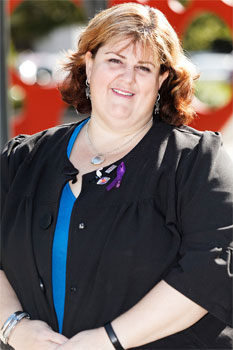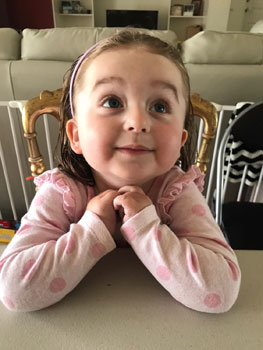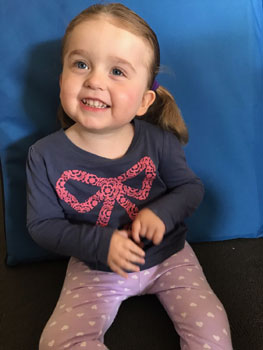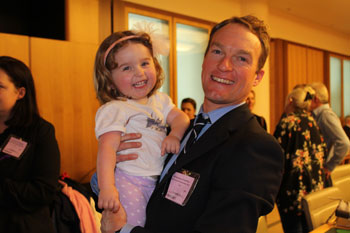Amanda Nave Spinal Muscular Atrophy Interview

SMA Is The Most Common Genetic Cause of Death in Children under Two Years of Age
Stephanie was diagnosed with SMA at 18 months of age, after she had failed to start walking earlier. From there, her mother Amanda describes the process as a 'whirlwind' of genetic tests, neurological exams and doctor's visits.
Amanda says the diagnosis and journey has been an emotional rollercoaster.
Stephanie, who is now two and a half, is wheelchair-bound, but moves independently. She has limited strength though, and even pressing buttons on a remote, or steering her wheelchair can require a great amount of effort. If Stephanie falls over, she is unable to sit up by herself.
Amanda and her husband Mark are always very conscious of the impact a respiratory infection could have on Stephanie, and try not to be around those who are sick, and even humidity control the house. In the back of their mind is the worry about other serious illnesses, which could affect Stephanie.
When Amanda had all her prenatal testing, SMA wasn't even mentioned, she had to do her own research after Stephanie was diagnosed.
Amanda's advice to other parents who are in a similar situation is to let yourself go through the little grief process of what you thought your life would be like. "Enjoy the kids why they're around," says Amanda. "Become your child's greatest advocate, because you will need to fight for them."
Despite the hardship, though, Amanda can't help but remain optimistic about the future, and for Stephanie.
 Interview with Amanda Nave
Interview with Amanda Nave
Question: How was Stephanie diagnosed with SMA?
Amanda Nave: Stephanie was still not walking at her 18-month check-up. She had a bout of the flu (along with the rest of the family) just prior and had lost the ability to sit up for very long as well. She saw a paediatric physiotherapist and a paediatrician who performed a neurological exam. He then ordered some blood tests and told us that he suspected a genetic neuromuscular issue. I had already done some research on Google and knew that on the basis of the neurological exam it was reduced to a list of four potential diseases, all of which meant Stephanie would be permanently in a wheelchair. It was three weeks until the genetic blood tests came back confirming SMA and then her type II status was determined by a visit to Royal Children's Hospital (RCH) in Melbourne, the following week.
Question: Can you talk about how SMA affects your daughter Stephanie?
Amanda Nave: Stephanie's gross motor function (the ability to move the larger muscle groups) is as developed as a three-four month old baby. She can sit unsupported for a few seconds (determining her type II status) but she has poor head control and can topple over easily once unbalanced. She can't put herself in an upright seated position. She cannot roll over, even onto her side from her back. If you place her on her side and she falls onto her tummy, she becomes distressed as she cannot roll over. She has lost the ability to feed herself with a spoon, she cannot throw a tennis ball single-handily anymore. She has never crawled or bum-shuffled. She has never pulled herself up to a stand. She can stand fully supported in a frame, which she does daily, but the effort to do it is comparable to us running a marathon. But as her fine motor skills are okay, she can do puzzles, paint (as long as the brush is light and the paint's not too thick) she can draw, but prefers felt-tips as she can't press crayons and pencils hard enough to get vibrant colours. She has trouble being able to sit on a toilet without a special support chair and she will probably never be able to reach to wipe her own bottom, but she is urinary and faecally continent. Eventually she may also have difficulty breathing and swallowing.
Question: How has Stephanie's diagnosis affected your whole family?
Amanda Nave: Basically, when we had a child and thought of all the things that were great about our childhoods and what we looked forward to doing with her, it was about activities that involved physical activity. After her diagnosis we had to read adjust what our life would be like from there. It would be a very different parenting experience to what we were expecting. No less rich, but different.
On top of that we had dozens of appointments with doctors, therapists, NDIS, assistive technology equipment providers and the first six months were a whirlwind. While my other friends were taking their similar-aged children to the zoo and concerts, we were either at appointments or just trying to take a breather at home. At our average trip to RCH we see seven specialists in the neuromuscular department alone. In the last year we have seen specialists in two other departments as well, in addition to her regular team of three therapists (physio, hydro, OT), paediatrician, GP and all the other age-related appointments. She has a daily homework program of all her therapies also and we do hydrotherapy twice weekly without the therapist. Sometimes time just has to be given for her to just be a kid…
 This is in addition to us parents trying to maintain our normal working lives and our own health-related appointments. As Stephanie has become larger, we have more focus on keeping ourselves physically in check with regards to the large amount of manual lifting. Stephanie is like lifting 12 kg of wet spaghetti – dead weight that wiggles and slips around. So we see a physio, chiropractor and osteopath on a semi-regular basis, try to maintain a regular strength-based exercise program and occasionally squeeze in a massage where time permits (usually when the aches and pains are too strong to ignore).
This is in addition to us parents trying to maintain our normal working lives and our own health-related appointments. As Stephanie has become larger, we have more focus on keeping ourselves physically in check with regards to the large amount of manual lifting. Stephanie is like lifting 12 kg of wet spaghetti – dead weight that wiggles and slips around. So we see a physio, chiropractor and osteopath on a semi-regular basis, try to maintain a regular strength-based exercise program and occasionally squeeze in a massage where time permits (usually when the aches and pains are too strong to ignore). The other thing that SMA does is remove your reproductive freedom. You can't just decide that you will have another baby without facing quite a large ethical dilemma. Do you throw caution to the wind, throw a dice and see what fate delivers? How would you feel to knowingly bring a child with a major life-threatening disability into the world? Would you consider aborting a child whom you know to be affected in utero? If you did, what message would this send to your existing child with the condition if they ever found out? Would you go through IVF and select embryos that were not affected? If you had another 'normal' child, what dynamic would there be in the household? Would it further highlight the differences between the child who couldn't participate fully and the 'normal' child who may miss out on things just because their sibling couldn't go? Would the 'normal' child feel neglected as the 'special needs' child required so much more care and attention?
These are all issues that are addressed with the genetic counselling provided by the hospital on diagnosis. Many families have a tough time comprehending the issues and working out what is the right decision for them. For us, Stephanie was our first and only child. In other families, the SMA child can already have 'normal' siblings and as many children are diagnosed around their 18-month birthday, many mothers are pregnant with a subsequent child at diagnosis which can increase the stress and complexity at diagnosis.
Question: How do you hope to raise awareness of SMA?
Amanda Nave: By doing interviews like this. Hopefully we can campaign to have SMA (along with Fragile X and Cystic Fibrosis (CF), which combined account for around 80% of the genetic-based infant morbidity in this country) added to the regular prenatal screening tests. I opted to have all the regular testing and was offered (and took up that offer) CF, but not offered SMA. SMA should also be added to the newborn screening tests to ensure that it is detected early.
Question: What advice do you have for other parents who have a child with SMA?
Amanda Nave: Live every day at a time, take nothing for granted and advocate for your child. They make us better people.
 Interview with Julie Cini, CEO, Spinal Muscular Atrophy Australia
Interview with Julie Cini, CEO, Spinal Muscular Atrophy Australia
Question: What is spinal muscular atrophy (SMA) II?
Julie Cini: SMA is the childhood version of motor neurone disease. SMA is an inherited genetic (it isn't contagious) muscle-wasting disease. Muscles affected are not only external muscles like arms and legs, that we can see, but also all internal muscles; including breathing, coughing and swallowing.
Question: What are the signs and symptoms of SMA?
Julie Cini: Signs and symptoms of type II SMA include diminished muscle tone, muscle weakness and floppiness. This usually occurs after six months of age. They can sit unaided, but usually cannot stand or walk. The legs are usually weaker than the arms. Children may also have feeding issues, and a weak cry. Children affected are late to achieve or do not reach milestones such as crawling or walking. Children with SMA have normal intelligence.
Interview by Brooke Hunter
MORE



